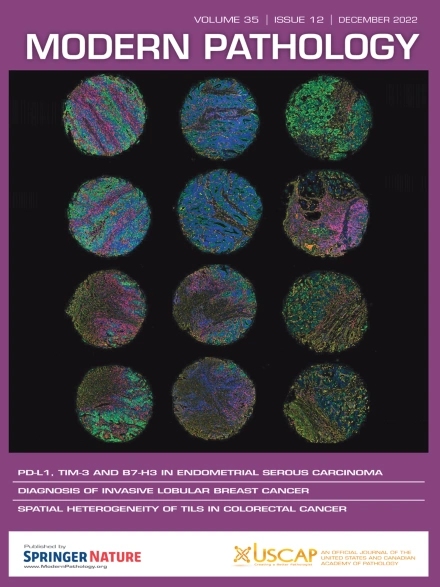源自低级别卵巢浆液性肿瘤的高级别癌的早期基因分化。
IF 7.1
1区 医学
Q1 PATHOLOGY
引用次数: 0
摘要
目前的研究范式认为,输卵管前体是大多数卵巢高级别浆液性癌(HGSC)的起源。然而,有一种罕见的 HGSC 子集是通过与低级别浆液性卵巢肿瘤(即浆液性边界瘤和低级别浆液性癌)不同的途径发展而来的。人们对 HGSC 和其他分化不良的卵巢癌的另一种发展途径还不甚了解。为了阐明低分化浆液性肿瘤组织学转化的分子发病机制和进化轨迹,我们对 7 例浆液性边界瘤或低分化浆液性癌伴有同步或间期不确定/高级别癌的低分化和高级别成分进行了显微解剖全外显子组测序。在大多数病例中,与每种成分特有的体细胞突变相比,匹配的低分级和高分级肿瘤之间共享的体细胞突变相对较少(即系统发生树的树干短、树枝长)。在特定患者的所有肿瘤样本中都存在的干突变包括已知的低分化浆液性肿瘤的驱动因子:KRAS(G12D,n=4)、BRAF(G469A,n=1)、NF2(n=1)和 USP9X(n=1)。3例患者的HGSC转化与双等位基因失活的TP53突变有关,所有病例均伴有严重的核不典型性,并与全基因组拷贝数改变和等位基因失衡有关。TP53野生型肿瘤具有不同的形态学特征,包括具有中度核不典型性和高有丝分裂活性的未定级浆液性癌,但缺乏广泛的染色体不稳定性(2例),以及低分化癌(2例,包括1例高级别穆勒氏癌和1例具有肉瘤特征的未分化癌)。总之,同步和近同步的低级别浆液性肿瘤和高级别癌是克隆相关的。早期遗传分化在 TP53 突变的病例中最为明显,这表明高级别转化可能是一个相对较早的分子事件。本文章由计算机程序翻译,如有差异,请以英文原文为准。
Early Genetic Divergence of High-Grade Carcinomas Originating from Low-Grade Serous Ovarian Neoplasms
The current paradigm implicates a fallopian tube precursor as the origin of most ovarian high-grade serous carcinomas (HGSCs). However, a rare subset of HGSCs develop via a distinct pathway from low-grade serous ovarian neoplasms (namely, serous borderline tumors and low-grade serous carcinoma). This alternate pathway for the development of HGSC and other poorly differentiated carcinomas of the ovary is not well understood. To elucidate the molecular pathogenesis and evolutionary trajectory of histologic transformation of low-grade serous neoplasms, we performed whole exome sequencing on microdissected low-grade and higher-grade components from 7 cases of serous borderline tumor or low-grade serous carcinoma associated with a synchronous or metachronous indeterminate/high-grade carcinoma. In most cases, there were relatively few somatic mutations shared between matched low-grade and higher-grade tumors compared with private mutations specific to each component (ie, phylogenetic trees with short trunks and long branches). Truncal mutations, present across all tumor samples from a given patient, included known drivers of low-grade serous neoplasms: KRAS (G12D, n = 4), BRAF (G469A, n = 1), NF2 (n = 1), and USP9X (n = 1). Transformation to HGSC was associated with a TP53 mutation with bi-allelic inactivation in 3 cases, all with severe nuclear atypia, and associated with genome-wide copy number alterations and allelic imbalances. TP53-wildtype tumors comprised a morphologic spectrum, which included indeterminate-grade serous carcinomas with moderate nuclear atypia and high mitotic activity, although lacking extensive chromosomal instability (n = 2) and poorly differentiated carcinomas (n = 2, including a high-grade Mullerian carcinoma and an undifferentiated carcinoma with sarcomatoid features). In summary, synchronous and metachronous low-grade serous neoplasms and higher-grade carcinomas are clonally related. Early genetic divergence, most evident in cases with TP53 mutations, suggests that high-grade transformation may be a relatively early molecular event.
求助全文
通过发布文献求助,成功后即可免费获取论文全文。
去求助
来源期刊

Modern Pathology
医学-病理学
CiteScore
14.30
自引率
2.70%
发文量
174
审稿时长
18 days
期刊介绍:
Modern Pathology, an international journal under the ownership of The United States & Canadian Academy of Pathology (USCAP), serves as an authoritative platform for publishing top-tier clinical and translational research studies in pathology.
Original manuscripts are the primary focus of Modern Pathology, complemented by impactful editorials, reviews, and practice guidelines covering all facets of precision diagnostics in human pathology. The journal's scope includes advancements in molecular diagnostics and genomic classifications of diseases, breakthroughs in immune-oncology, computational science, applied bioinformatics, and digital pathology.
 求助内容:
求助内容: 应助结果提醒方式:
应助结果提醒方式:


